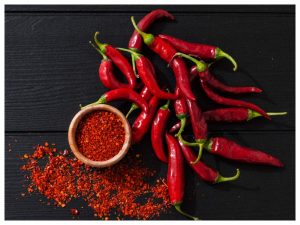Most Important Guidelines About Chilli Cultivation in India

Chilli is believed to have originated from America. There are many varieties of chillies, and each variety grown in different places has a different taste. Chilli is a significant ingredient in Indian cuisine as well as any international cuisine. Chilli Cultivation in India The use of chillies in various dishes makes it an essential part of cooking. We introduce chilli peppers to Asia as well as India by Portuguese traders. The use of chillies in Goa cuisine is much higher than in other parts of India, which correlates to the presence of Portuguese traders.
Chilli Cultivation in India is most famous farming way to increase the farmers wealth. You can measure the intensity of heat of chilli in Scoville heat units(SHU)). The intensity of heat varies in different varieties of chilli. Because we use chilli in different forms in different cuisines. Chillies are ground into a paste, dried into chilli powder and use in various dishes.
We address the chilli farming operations that require reliable equipment for every Indian farmer. The farmers often use the Sonalika tractor that is frequently used in farming. Farmers also need rotavators, cultivators and tillage for agriculture.
Production, Area and Productivity of chilli in India
Farmers grow chillies all over the world and in many places in India. Farmers cultivate the chilli in many states like Uttar Pradesh, Karnataka, Andhra Pradesh, Maharashtra, Tamil Nadu, Telangana, Punjab and West Bengal. The average production of chilli is 574 to 957 kg per hectare.
Cultivation Requirements For Chilli Cultivation
1. Climate and Seasons
Chilli is a crop that grows well in a hot and humid climate with a temperature of 20°C to 25°C. The crop prefers high moisture content as low moisture causes fruit drop. Although you require good rain for the crop, excessive rain is not good as it spoils the crop. The sowing time for Kharif is May-June, and for the summer crop, the sowing time is in January.

2. Soils
Farmers can grow chillies in a wide variety of soils, although black soils are suitable for chilli cultivation. Loose sandy soil and delta land are also good. However, you need to be careful that the water is not stagnant and well-drained, damaging the crop.
Crop Management:-
1. Field Preparation
Farmers should choose well-drained and well-ventilated land for chilli cultivation. They should do 2-3 ploughs of the land and apply manure 15 to 20 days before sowing. Give the break of 10 days and then plough the soil. The excess moisture will evaporate, and the loose condition of the soil will improve.
2. Sowing and Transplanting
Farmers should first sow chilli seeds in well-prepared nursery beds, which can be 60 cm-100 cm in width with suitable and preferred length. You should use good quality, well-formed seeds for sowing.
3. Seed Rate
Seed requires 1 to 1.5 kg for a 1-hectare area. It is necessary to prepare the field properly and take care of the drainage problems to get good results. Since warm weather conditions are very suitable for the crop, it is good to grow in such conditions.
Chilli requires proper care in the early stages of the crop and the stages of germination. You can use greenhouses for chilli cultivation in adverse weather conditions to help seed germination and early plant growth. The farmers Also use the Mahindra tractor that is frequently used in farming. Direct sowing of chilli seeds in the main field is not a good idea and you should avoid it.
4. Transplanting
Transplanting chilli plants requires hardening of the plants to withstand climatic and soil conditions. Farmers should protect the plants for 3-6 weeks; later, farmers can transplant chilli plants in the main field area or separate pots. A chilli plant that is not flowering or ready to flower is perfect for transplant. It is best to pick up chilli plants from a nursery or greenhouse as they will be of the same variety, quality and size. You should grow plants in containers or pots as they have better soil conditions and you can plant with good rooting conditions.
5. Spacing
Spacing is the most prominent factor to get good results. Adequate spacing should be there for the proper growth of each plant. 60 -70 cm is considered to be good spacing for most of the soils. The particular characteristics of a variety you should consider while transplanting. The size of the plant and the particular health condition of a plant you should consider so that all the plants get enough nutrients.
Water Management
Chilli plants need enough water for their growth. But, notably, water does not stagnate in nursery beds and fields. On the contrary, too much moisture can cause fungal infections in pepper plants. Therefore, you should be careful when watering the plants and when you need the plant, give the water. A very good solution would be to water the plants at 4 pm when the leaves start falling. Flowering and fruiting stages are the most prominent stages in chilli cultivation during these stages, such as avoiding excessive use of fertilizers, insecticides and fungicides.
In the guidelines of this farming, We came here to inform you of some important points about chilli farming. In such a way, we recommend the Swaraj tractor for every Indian farmer. However, Chilli farming requires a lot of equipment such as a Rotavator, Cultivator, Tillage and many more.
For more information regarding Chilli farming and any other farming, stay tuned with us.



